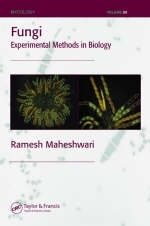
Fungi
Crc Press Inc (Verlag)
978-1-57444-468-1 (ISBN)
- Titel erscheint in neuer Auflage
- Artikel merken
Today’s accelerated pace of research, aided by new instruments and techniques that combine the approaches of genetics, biochemistry, and cell biology, has changed the character of mycology. A new approach is necessary for the organization and study of fungi.
Fungi: Experimental Methods in Biology presents the latest information in fungal biology generated through the application of genetics, molecular biology, and biochemistry. This book analyzes information derived through real experiments, and focuses on unresolved questions in the field. Divided into six sections comprising 14 chapters, the text describes the special features of fungi, interactions of fungi with other organisms, model fungi in research, gene manipulation, adaptations, and natural populations.
Each chapter is self-contained and written in a style that enables the reader to progress from elementary concepts to advanced research, benefiting both beginning research workers and experienced professionals. A comprehensive appendix covers the principles in naming fungi and discusses their broad classification.
The Unique Features of Fungi
The Hyphal Mode of Life
Features of Hyphae
Cell Wall
Mycelium Formation
Concluding Remarks
The Multinuclear Condition
Nuclear Number and Hyphal Growth
Chromosome Numbers
Nuclear Division Cycle
Asynchronous Nuclear Divisions
Nuclear Migration
Positioning of Nuclei and Gene Regulation
Heterokaryosis
Parasexual Recombination
Concluding Remarks
Interactions of Fungi with other Organisms
Fungi as Symbiotic Partners
Mycorrhiza
Lichen
Some Unanswered Questions
Fungi as Plant Pathogens
Early Ideas on Plant Diseases
Some Striking Fungal Diseases
Classes of Plant Pathogenic Fungi
General Features of Pathogenesis
Concluding Remarks
Model Fungi in Research
Neurospora: A Gateway to Biology
Habitat, Life Style, and Life Cycle
Meiotic Events
Gene Maps
One-Gene-One-Enzyme Hypothesis
Molecular Revolution
Revelations from Genome Sequence
Concluding Remarks
Yeast: A Unicellular Paradigm for Complex Biological Processes
Molecular Mechanisms of DNA Replication and Cell Division
Bud Growth and Polarity
Mating and Signal Transduction Cascade
Protein Targeting
Mitochondrial Biogenesis
Functional Genomics
Proteomics and System Biology Modeling
Concluding Remarks
Aspergillus nidulans: A Model for Study of Form and Asexual Reproduction
Conidiophore Morphogenesis
Microcycle Conidiation
Conidiation Genes
Conidiation Trigger
Regulatory Pathway
Summary
Ustilago maydis: Mechanisms in Sexual Reproduction
Heterothallism vs. Homothallism
Cell-Cell Recognition
Extracellular Recognition
Intracellular Recognition
Overview
Gene Manipulation in Fungi
Transformation of Fungi and Discovery of Gene-Silencing Phenomena
Transformation Procedure
Hologous vs. Ectopic Integration of Transgene
Purification of Transformant
Gene-Silencing Phenomena
Concluding Remarks
Adaptations
Thermophilic Fungi: Eukaryotic Life at High Temperature
Discovery
Distribution in Soil
Physiology
Sectretory Enzymes
Concluding Remarks
Photoresponses and Circadian Rhythm
Types of Photoresponses in Fungi
Circadian Rhythm in Neurospora
Entrainment
Summary
Decomposition of Biomass
Decay of Wood and Litter
Biochemistry of Degradation of Cell Wall Polymers
Concluding Remarks
Populations
Species, Their Diversity and Populations
Value of Diversity
Number of Fungal Species
Species Recognition
Discovery of Intraspecies Variability
Generation of Variation
Detection of Genetic Variation in Populations
Speciation
Concluding Remarks
Senescence
Discovery of Senescing Strains
Distinguishing Nucleus and Mitochondria Based Senescence
Senescence in Podospora anserina
Plasmid-Based Senescence in Neurospora
Nuclear Gene Mutants
Aerobic Respiration, Aging, and Senescence
Concluding Remarks
Appendix: Naming, Defining, and broadly classifying fungi
Naming of Fungi
Definition of a Fungus
Classification
A Broad Classification of Fungi
Kingdom Straminipila (Stramenopila)
General References
| Erscheint lt. Verlag | 23.6.2005 |
|---|---|
| Reihe/Serie | Mycology |
| Zusatzinfo | 10 Halftones, black and white; 8 Tables, black and white; 7 Illustrations, color; 145 Illustrations, black and white |
| Verlagsort | Bosa Roca |
| Sprache | englisch |
| Maße | 178 x 254 mm |
| Gewicht | 726 g |
| Themenwelt | Naturwissenschaften ► Biologie ► Botanik |
| Naturwissenschaften ► Biologie ► Mikrobiologie / Immunologie | |
| Naturwissenschaften ► Biologie ► Mykologie | |
| Technik ► Umwelttechnik / Biotechnologie | |
| ISBN-10 | 1-57444-468-9 / 1574444689 |
| ISBN-13 | 978-1-57444-468-1 / 9781574444681 |
| Zustand | Neuware |
| Haben Sie eine Frage zum Produkt? |
aus dem Bereich



